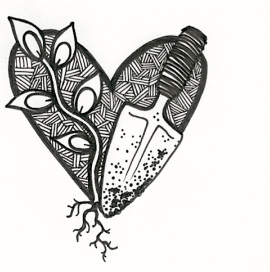"I feel that there is nothing more truly artistic than to love people." ~ Van Gogh
About Placecraft

Placecraft is Cultivating a sense of Place:
a sense of Place on Earth and a sense of place within our Spirits, bringing Life to places in the physical world and enlivening the Soul. Supporting community permaculture and placemaking projects by providing classes and educational material. We encourage the power, wisdom, and creativity the group to bring out the unique gifts in each project by collaborative facilitation and training future project organizers.
We work with individuals and groups and combine practical hands-on skills with our Hearts to infuse the work that we undertake with beauty, purpose, and joy.
We strive to provide educational workshops and use the blog for teachable moments, gardening and community organizing tutorials, stories, poetry, and thoughtful ramblings.
a sense of Place on Earth and a sense of place within our Spirits, bringing Life to places in the physical world and enlivening the Soul. Supporting community permaculture and placemaking projects by providing classes and educational material. We encourage the power, wisdom, and creativity the group to bring out the unique gifts in each project by collaborative facilitation and training future project organizers.
We work with individuals and groups and combine practical hands-on skills with our Hearts to infuse the work that we undertake with beauty, purpose, and joy.
We strive to provide educational workshops and use the blog for teachable moments, gardening and community organizing tutorials, stories, poetry, and thoughtful ramblings.
"Placecraft" as a name actually began in 2012 as a small design/build team (our old website) which I (Placecraft Organizer, Hannah Poirier) was a member of. Our focus was straw-clay insulation retrofits in the Portland area in celebration of Light Straw-Clay's then-recent legalization for the state of Oregon. The Placecraft crew worked on one complete project together, made big plans to become a cohesive community retrofit team, and dissolved soon after into each of us tuning into our own separate projects. I adopted the name after about a year of fallowing.
For those interested in really geeking out with me, when we were choosing our name back then, I had some excitement around everything Placecraft meant to me at the time (9/8/11):
Place: A memory-rich 'space' which is created by the people who use it, in a manner which meet their agreed upon needs as a community. It stands apart from social spaces which are not created by the people who use it in that the very form reflects who they are, and the process of creation ties directly into their particular culture.
Places rely so heavily on a feeling, thoughts, memory... that 'ideas' are arguably 'places', thus offering a shift in thought (how can we run a business and strive for social equality, how can we build without manufactured materials, how do we build community with a change in landscape) is also a creation of place, for an idea to exist.
Craft: A lost art of creating functional things which people can value for their usefulness, durability, and beauty. Crafts are things people can care about. A craftperson is a functional artist. Carpenters, potters, toolmakers... the useful niches in a social ecology that industrial culture has perhaps hurt the most.
Placecrafters: Functional artists who seek to facilitate the creation of places that can be cared about.
A Crafted Place: Implies a Place (which doesn't necessarily have to be structural) that incorporates some physical creation that is hand-made.
Crafting Places: Even if "place" is just another word for a "space" that doesn't mean anything, by crafting places we're suggesting that we're putting more care into making places, rather than just making another 'space'. We're not Spacemakers, we're Placecrafters. Factories can 'make' things, but only humans that care can be craftspeople.
Spacecraft: A way to travel into outer-space, the unknown, the infinite, yet the patterns of the way in which galaxies move are the same in which things operate on a molecular level... Permaculture teaches to design from patterns to details, and we can use our core value of 'learning' to notice patterns in the world (earth & universal) to dictate the way in which we design things.
For those interested in really geeking out with me, when we were choosing our name back then, I had some excitement around everything Placecraft meant to me at the time (9/8/11):
Place: A memory-rich 'space' which is created by the people who use it, in a manner which meet their agreed upon needs as a community. It stands apart from social spaces which are not created by the people who use it in that the very form reflects who they are, and the process of creation ties directly into their particular culture.
Places rely so heavily on a feeling, thoughts, memory... that 'ideas' are arguably 'places', thus offering a shift in thought (how can we run a business and strive for social equality, how can we build without manufactured materials, how do we build community with a change in landscape) is also a creation of place, for an idea to exist.
Craft: A lost art of creating functional things which people can value for their usefulness, durability, and beauty. Crafts are things people can care about. A craftperson is a functional artist. Carpenters, potters, toolmakers... the useful niches in a social ecology that industrial culture has perhaps hurt the most.
Placecrafters: Functional artists who seek to facilitate the creation of places that can be cared about.
A Crafted Place: Implies a Place (which doesn't necessarily have to be structural) that incorporates some physical creation that is hand-made.
Crafting Places: Even if "place" is just another word for a "space" that doesn't mean anything, by crafting places we're suggesting that we're putting more care into making places, rather than just making another 'space'. We're not Spacemakers, we're Placecrafters. Factories can 'make' things, but only humans that care can be craftspeople.
Spacecraft: A way to travel into outer-space, the unknown, the infinite, yet the patterns of the way in which galaxies move are the same in which things operate on a molecular level... Permaculture teaches to design from patterns to details, and we can use our core value of 'learning' to notice patterns in the world (earth & universal) to dictate the way in which we design things.

